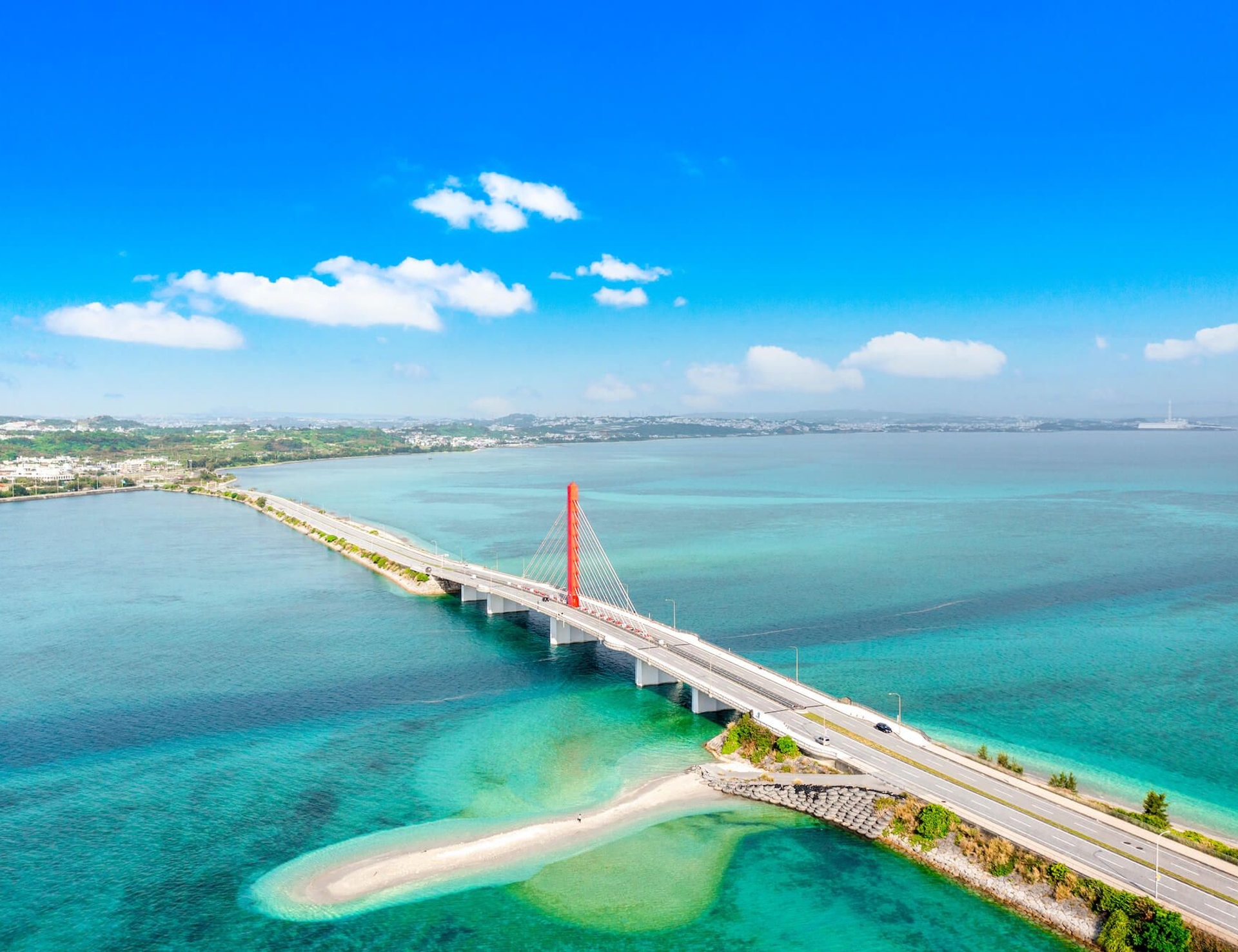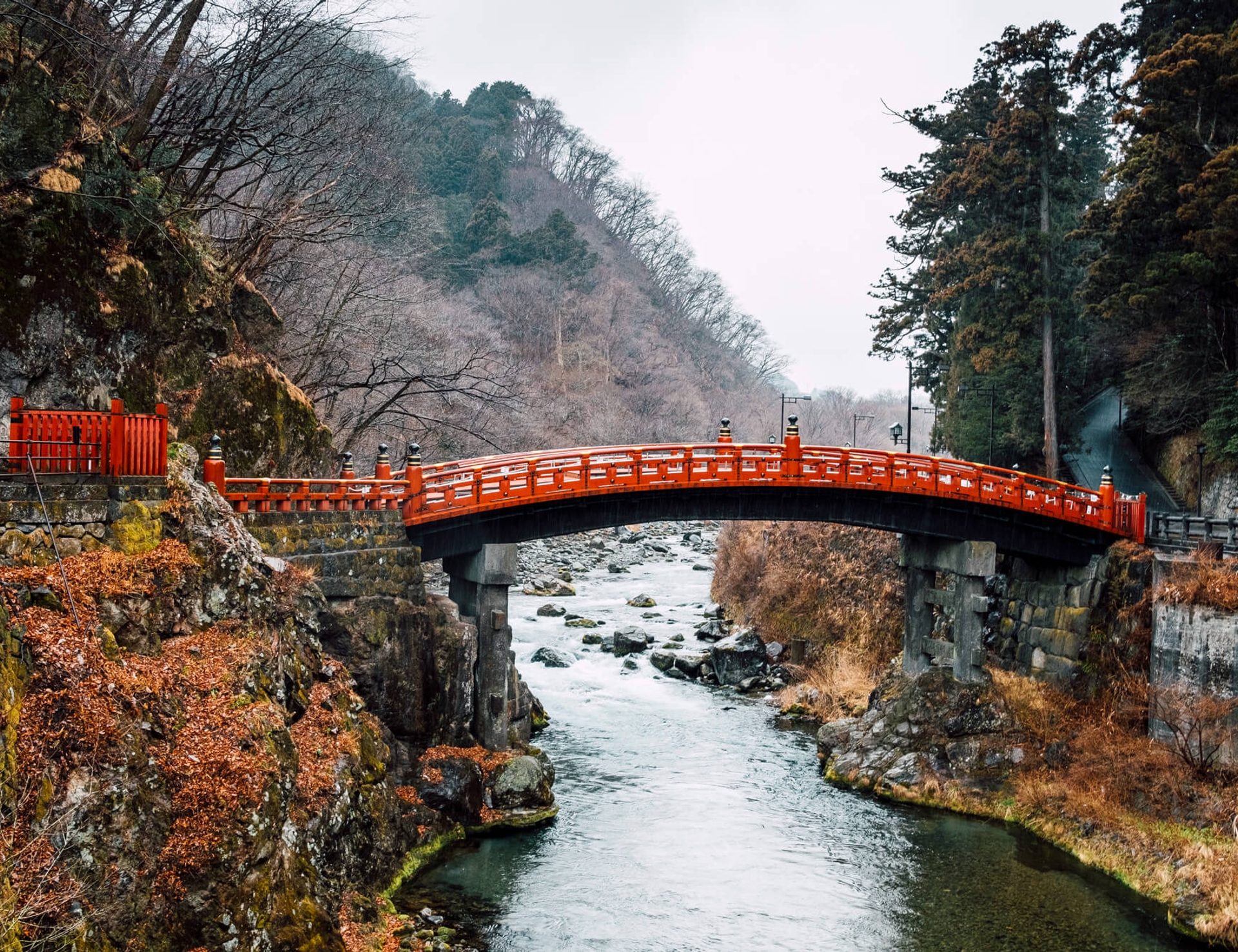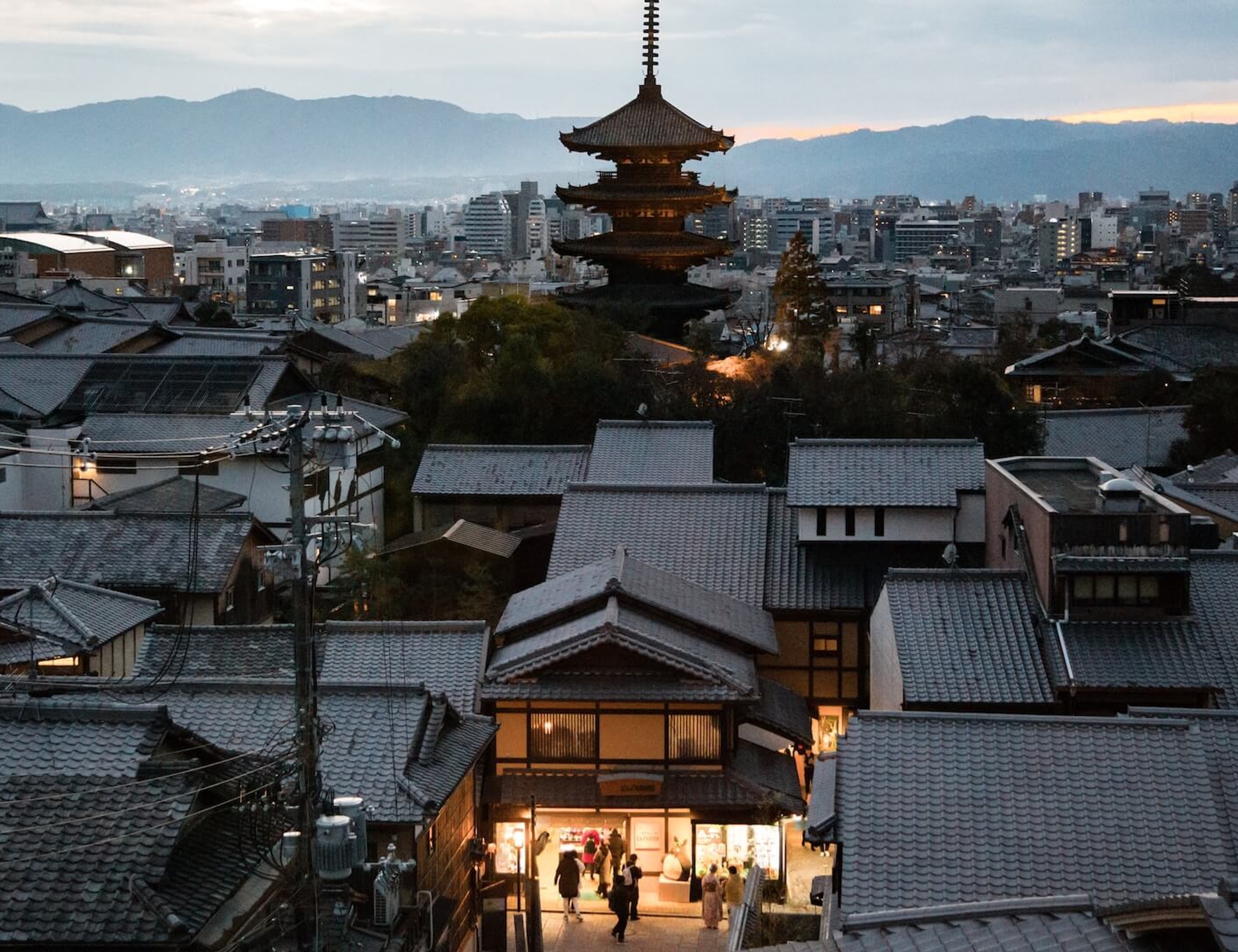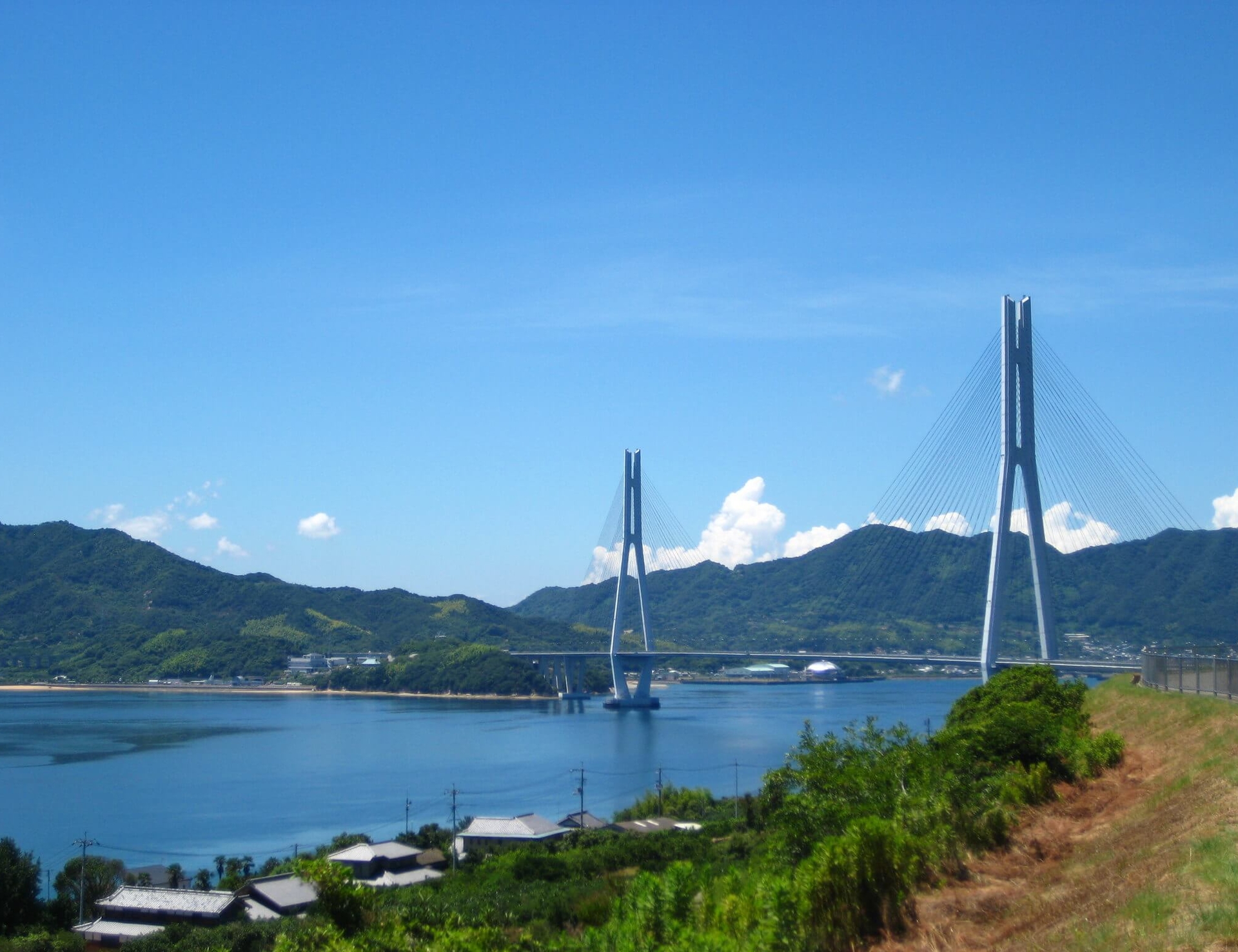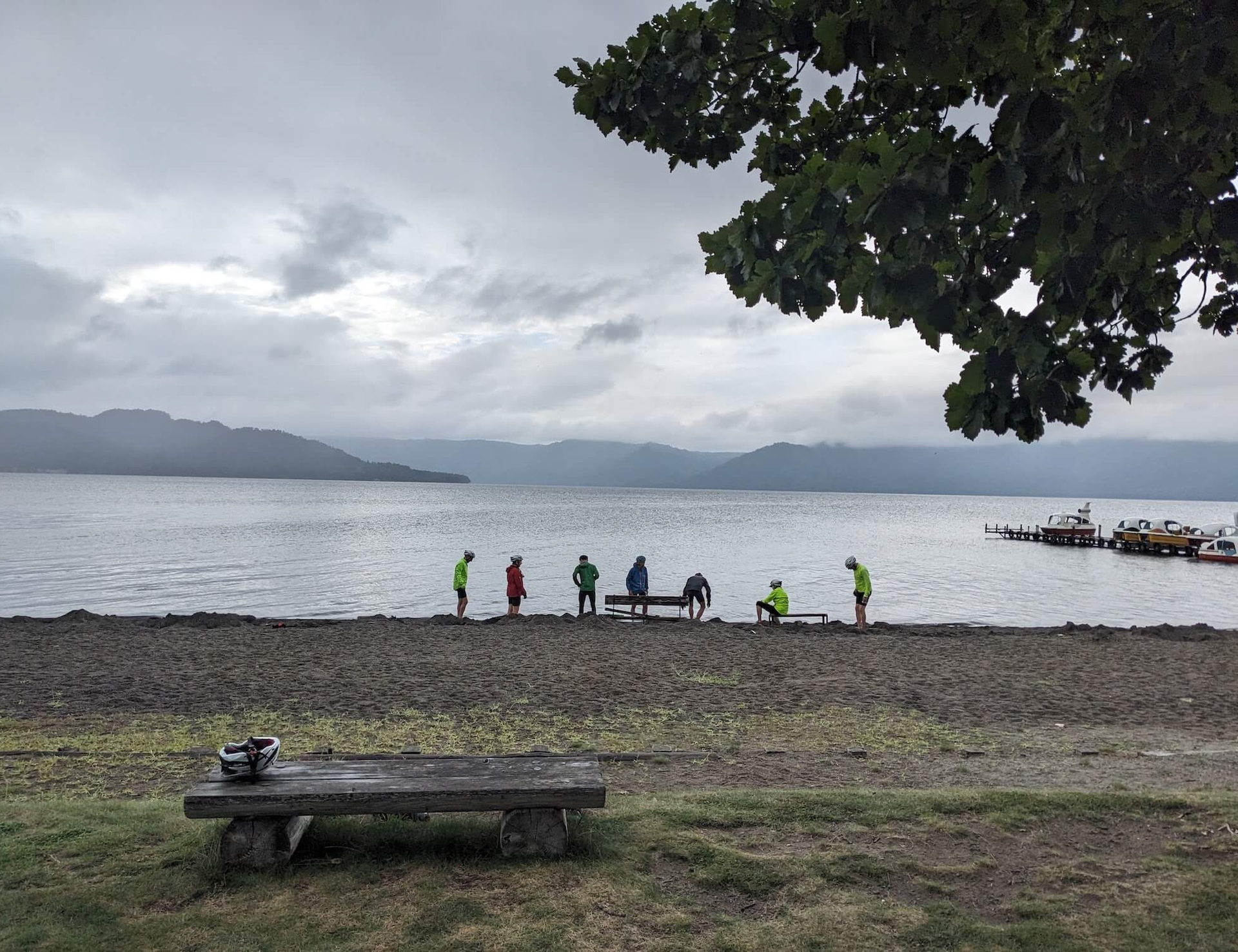
Table of Contents
- 1. Understanding Japan
- 2. Why Go Cycling Japan?
- 3. What are the Best Places to Cycle in Japan?
- 4. What are the Best Cycling Routes in Japan?
- 5. When is the Best Time to Cycle in Japan?
- 6. Enjoying Japanese Cuisine
- 7. Japan Visa Requirements
- 8. Vaccines and Medicines
- 9. Handy Info
- 10. Through the Notes
- 11. Embrace the Bike Tour in Japan
Understanding Japan
Topography
Japan is an island country in the Pacific Ocean located between 20° to 45°N latitude and 122° to 153° E longitude. About 75% of Japan is mountainous, and nearly 66% of its area is covered under forests.
Japan also has the sixth longest coastline in the world, which means the sea and beautiful beaches are a constant companion when cycle touring in Japan.
There are five main islands in Japan — Hokkaido, Honshu, Kyushu, Shikoku, and Okinawa — along with another 14,120 smaller islands, and the cycling is often focused on covering one island.
When cycling in Japan, riders can expect hills, forests of pine, beech, and bamboo, and great views of the sea. Expect an average of 60 km/36 miles of cycling each day.
Climate
Most of Japan has a temperate climate with average temperatures in the range of 10-20°C throughout the year. The exceptions are Japan’s northern and southernmost islands — Hokkaido and Kyushu. However, proximity to sea exerts a moderating influence even on the climates of both these islands.
Flora and Fauna
Japan has a high diversity of flora and fauna, and high rate of biological endemism, meaning many species and plants and animals found in Japan are found nowhere else. Cyclists often encounter animals such as the Sika deer, the Ezo red Fox, and the Japanese macaque monkey, which is often spotted in the vicinity of onsen hot springs.
Oaks, pines, and cypresses are the most common trees in the northern islands and on the mountains, while bamboos and camphors are found in the more tropical regions. Cherry and plum trees, famous for their blossoms in spring, and found on all the four major islands of Japan.
Economy
Japan is a highly developed country, with the highest life expectancy in the world. It is a great destination for cycling, with a well-developed road network, little traffic in the countryside, and great infrastructure.
DREAMING OF CYCLING IN JAPAN?
Explore our amazing bike tours in Japan now!
Why Go Cycling Japan?
Here are 6 reasons why you should consider cycling Japan:
-
Charming Natural Beauty: Japan is a land of unsurpassed natural beauty that really comes alive on a cycling trip. Much of Japan beyond the usual tourist haunts consists of unexplored wilderness and mountains. A Japan bike tour allows you to explore the virgin Taiga forests and crystal-clear lakes in Hokkaido, the magical sight of millions of firefly squid glowing under the water at Toyama Bay, the 1,000 rice paddies of Wajima in Noto, and much more.
-
Onsen Hot Springs: Japan has one of the largest number of hot springs in the world. This is because Japan is essentially one large volcanic archipelago, allowing for mineral-rich geothermal springs to gush forth from under the surface Onsen hot spring baths are an integral part of Japanese culture, and at Art of Bicycle Trips, we’ve designed all our Japan cycling tours keeping onsen hot springs as one of the tour highlights. To dip yourself in the soothing, hot waters of an onsen after a long day of biking is an experience every cyclist needs to have at least once.
-
History (and a Glimpse of the Future): Japan is a place where nearly 5,000 years of unbroken tradition meets futuristic tech. Only on a Japan bike trip can you expect vistas to seamlessly change from ancient Buddhist temples to high-tech bullet trains. No other country in the world has such strong ties to its ancient and well-preserved past, while being so invested in the future at the same time. A Japan cycling tour is perhaps the closest thing to time travel you’ll ever experience.
-
Culture: The Japanese are known for their dedication to perfection, their heightened sense of aesthetics, and their unmatched hospitality. When cycling in Japan, expect great hospitality, friendly locals, safe roads, and in general, the very best of everything.
-
Delicious Food: Japanese cuisine consistently rates among the best in the world. Whether it's sushi from Toyama, ramen from Tonkotsu, kelp from Rausu, or sake from Kochi, each region of Japan is known for its own specialty. On a Japan biking tour, you get the chance to savor each specialty right from the source.
-
Stay in Ryokans: Ryokans are traditional Japanese inns built in the traditional Japanese style, with sliding doors and tatami mats. At most Ryokans, guests are expected to exchange their shoes and clothing and slip into comfortable Japanese slippers and a Yukata robe, before being served delicious multi-course Japanese food in the kaiseki style. A Ryokan experience is quite unlike any other western style hotel experience in the world.
What are the Best Places to Cycle in Japan?
Japan offers a diverse and beautiful landscape for cycling enthusiasts, from scenic coastal routes to challenging mountain climbs. Here are some of the best places to cycle in Japan:
1. Kyoto & Tango Peninsula
Kyoto is called the cultural capital of Japan. With over 17 UNESCO World Heritage Sites and 1600 Buddhist and Shinto temples spread across Kyoto prefecture, it is brimming with sights and sounds for the cyclist to explore. The Tango Peninsula within Kyoto, in particular, is imbued with exceptional natural beauty, with its white sand beaches, forest covered hills and several onsens, making it an excellent place to cycle.
2. Hokkaido
Japan’s northernmost island, bordering Russia, Hokkaido is sparsely populated. Which means cyclists can expect little traffic on roads as they enjoy its natural beauty. Hokkaido has a wealth of large, crystal clear lakes, including Lake Mashu, one of the clearest lakes in the world.
Covered with virgin, unspoiled alpine forests, national parks, and natural hot springs, Hokkaido is a nature lover’s paradise. Wildlife lovers can expect to spot some rare fauna here, such as the Blakiston Fish Owl, the largest owl species in the world, and the Sika deer, one of the largest deer species in the world.
The Shiretoko Peninsula and the Furano-Biei area are very popular for cycling in Hokkaido as the area offers a variety of terrains, including flat coastal roads, rolling hills, and challenging mountain routes.
Read a comprehensive guide to cycling Hokkaido here.
3. Noto Peninsula
Located on Japan’s west coast, Noto Peninsula is a remote region known for its breathtaking views of the Sea of Japan and quiet country roads. Noto is also the only region in Japan where salt is still made using the ancient Agehama technique of bringing sea water to salt evaporation ponds and drying it. The salt prepared using this technique is highly valued all over Japan, and is recognized as an important intangible folk cultural property of Japan.
The indigenous and novel techniques of rice cultivation all over Noto not only make for beautiful sights, they’re also culturally significant. In fact, the entire peninsula has been designated by the UN as a Globally Important Agricultural Heritage System (GIAHS).
Toyama Bay, overlooking the Sea Japan is another Noto highlight. The bay is a breeding ground known for the bioluminescent firefly squid. Each year in Spring, they gather in large numbers near the bay, presenting a visual spectacle of a sea seemingly lit up from under the water.
The city of Kanazawa in Noto is famous for its Kanazawa Gold Leaf Craft. In Japan, gold leaf is used for a variety of purposes — from decorating places to worship to embellishing food. And Kanazawa produces nearly 100% of all the gold leaf produced in Japan. Gold leaf production is a complex craft, with craftsmen often required to produce a leaf so thin that it withers away if rubbed between the fingers of a hand. Kanazawa gold leaf production has been recognized as a UNESCO Intangible Cultural Heritage of the World.
4. Kyushu
Kyushu is home to Japan’s largest active volcano, Mount Aso. It is also famous for Beppu Onsen, a series of 3,000 geothermal springs in the town of Beppu that have the largest volume of hot water in Japan. For food lovers, Tonkotsu Ramen from Kyushu is a must-try, as it is considered the king of ramens.
5. Shikoku
Shikoku is home to 88 ancient Buddhist temples that are collectively known as the 88 pilgrimages. Spread out across Shikoku, these beautiful temples are an integral part of the Japanese cultural landscape. The 88 Temple Pilgrimage route is a popular cycling destination, taking you through serene countryside and coastal areas.
Shikoku is also known for its sake. Sake is the national beverage of Japan, and Shikoku produces some of the finest sake in all of Japan. The Kochi prefecture of Shikoku has the highest Sake consumption in all of Japan, and is known for producing premium sake such as Suigei Tokubetsu Junmai.
Close to Shikoku, the Shimanami Kaido 70-kilometer cycling route is extremely popular. It connects six islands in the Seto Inland Sea and offers stunning views of the ocean, bridges, and countryside. It's a well-maintained route with dedicated cycling lanes and rental shops.
What are the Best Cycling Routes in Japan?
This cycling route begins from Kanazawa, a city famous for its classic architecture, landscaped gardens, and its gold leaf craft which is recognized by UNESCO as an intangible cultural heritage of the world. The route then follows the peninsular coast along the Sea of Japan, offering spectacular vistas of the sea on one side, and lush green mountain sides on the other, before ending at the famous Toyama Bay.
Highlights:
- Chirihama-Nagisa Driveway, an 8 km stretch of packed sand where you get to bike on the beach itself
- Hatago Iwa, or married rocks, a pair of rock formations that are considered sacred in Japanese Shinto religion
- The 1,000 rice paddies of Wajima
- Wakura Onsen, a 1200 year old hot spring resort
- Toyama Bay, known for being home to the bioluminescent firefly squid
This loop starts at Abashiri, a city sandwiched between a large lake and the Sea of Okhotsk. It then follows the coastal road, providing excellent views of the sea, before curving back in to finish at Abashiri. En route lie numerous volcanic lakes, rolling hills, and rejuvenating onsens.
Highlights:
- Lake Mashu, one of the clearest lakes in the world
- Spectacular terrain, consisting of rolling hills, well-preserved forests, and crystal-clear lakes
- A chance to spot the Blakiston Fish Owl, the largest owl species in the world
- Excellent local seafood, including the rare and highly-regarded Rausu kelp that only grows in eastern Hokkaido
This ride starts from Kyoto and meanders through the Tango Peninsula before ending at Amanohashidate on the Sea of Japan.
Highlights:
- Visit iconic Kyoto landmarks such as the Golden Pavilion and the Kiyomizu Temple.
- Learn about silk production at the Gunze Museum in Ayabe
- Visit beautiful medieval castles built in the traditional Japanese style, including the Fukuchiyama castle, and Takeda castle perched high-up in the mountains
- Ride past gorgeous white sand beaches and funaya boathouses
- Stay at the Amanohashidate or heaven’s bridge, one of the most iconic sites in Japan
PLANNING A CYCLING HOLIDAY IN JAPAN?
Dive into our curated Japan cycling adventures today!
When is the Best Time to Cycle in Japan?
The best times to visit Japan are Spring (March to Mid-May) and Fall (September to mid-November). The average temperature hovers around 15°C - 22°C during this time.
However, given the latitudinal expanse of Japan, there can be regional variations in weather. Below, we’ve broken down the best time for biking in Japan in each of the major cycling regions in detail.
- Hokkaido
Best Season: July to September
This is the best time to visit Hokkaido as it coincides with the summer on the island. Temperatures hover around 20-25 °C and there is very little rain.
Shoulder Season: April to June and October
April to June is spring in Hokkaido. Daytime temperatures are between 7 to 15°C. Cherry blossoms begin to show up by the middle of May. There is considerably less tourist footfall, and this season is ideal for those who prefer to avoid the peak season crowd.
October is the fall season in Hokkaido, which turns the flora into brilliant shades of red and orange, presenting a spectacular sight. The average temperature is around 10°C. Southern Hokkaido tends to receive a fair amount of rainfall in the first week of October. Like spring, there is considerably less tourist footfall in October, although Hokkaido remains beautiful and welcoming.
Off-Season: November to March
November is the beginning of winter in Hokkaido. The first snow of the season begins to fall by mid-November. The first half of November, however, is good for cycling. Make sure to carry adequate winter clothing though.
- Noto Peninsula
Noto peninsula is considered an all-year round destination, as it has a relatively longer window of great weather suited for cycling.
Best Season: Spring (mid-April to mid-June) and Fall (mid-September to end-October)
Spring arrives in the Noto peninsula towards the end of March and lasts till the first week of June. Temperatures vary between 10 to 25°C during this time with very little rainfall. Cherry blossoms occur in mid-April in the Noto peninsula. The Noto-Kashima train station, where over a hundred cherry trees form a beautiful pink canopy, is one of the most popular spots for enjoying cherry blossoms in this season.
The arrival of fall in October sees similarly excellent weather, but with the vegetation now changing color to brilliant shades of orange and red.
Shoulder Season: Summer (July to mid-September)
The temperature and humidity begin to rise in July, but it is still pleasant enough for biking for the most part. Maximum day time temperatures can reach up to 30°C. July also sees more rainfall than previous months.
An interesting sight cyclists can expect to see during summer in Noto peninsula are Kiriko festivals — community-based events in which beautifully decorated lantern floats are paraded through towns and portable shrines are set on fire and submerged into the sea. The locals believe that doing so burns away the community’s misfortunes.
Off-Season: Winter (Mid-November to March)
Winter arrives in Noto towards the end of November. Snow begins to fall in the first week of December and begins melting in March.
- Kyoto
Like Noto, Kyoto has a temperate climate and can be visited all year round.
Best Season: Spring (end of March to mid-June) and Fall (September to early-November)
The average temperature in spring varies from 10 to 25°C. Late March to early April is the time for plum and cherry blossoms. This is also the time when tourists begin to arrive in Kyoto in large numbers.
Enjoying Japanese Cuisine
Japanese cuisine is widely regarded as among the finest in the world. A Japan biking tour offers visitors the chance to sample the best of Japanese cuisines. Here are five must have dishes to try when biking in Japan:
-
Sushi Sushi is vinegared rice wrapped in seafood or vegetables. There are at least seven major types of sushi, with each region of Japan having its own distinctive style.
-
Tempura Tempura is a deep fried pastry filled with either vegetables or fish. Its batter is prepared by mixing wheat flour with eggs and iced water. The use of cold water results in a very crisp and fluffy texture when fried. Traditionally, sesame oil was used to fry the batter. Tempura is served with soy sauce.
-
Ramen Ramen are wheat noodles served in a broth and served with different toppings such as egg, sliced pork, or bamboo shoots. Different regions of Japan have their own variations of ramen, however the most famous varieties are the tonkotsu ramen of Kyushu and miso ramen of Hokkaido.
-
Sakuramochi Sakuramochi is a popular Japanese dessert that is made by pounding short-grain Japonica rice into a cake and mixing it with sugar and cornstarch. It is filled with red adzuki bean paste and wrapped in pickled cherry blossom leaves. The dish is most commonly eaten during spring, especially after the Japanese celebrations of Hanami or flower-viewing celebrations.
-
Umeshu Umeshu or Japanese Plum Wine is a liqueur made by fermenting unripe plums in liquor and sugar, and allowed to mature for at least nine months. The resulting drink has an alcohol content of about 10-20% and a sweet taste with mild notes of sourness. Umeshu is commonly made in Japanese homes, and can be served both cold and hot, depending on the season. The Japanese plum tree, like the cherry tree, blossoms with beautiful lilac colored flowers in spring. In fact, long before cherry blossoms became a symbol of spring in Japan, plum blossoms were the original symbol of spring and celebration in Japan.
Japan Visa Requirements
Japan has a liberal visa policy and allows citizens of up to 70 countries/regions visa-free stay for up to 90 days. These include the US, UK, Canada, Australia, New Zealand, all citizens of the European Union, Israel, and South Africa to name a few. The complete list of visa-exempt countries can be viewed on the Japanese Ministry of Foreign Affairs website.
Citizens of other countries may need to apply for a visa to enter Japan. The following documents are needed for a Japan visa:
- A valid passport
- Proof of sufficient funds to cover the applicant’s stay in Japan
- Entry and departure tickets showing dates of arrival and departure
- Travel itinerary
- Passport size photograph
Citizens of a select few countries are eligible to apply for a Japanese eVisa online. The list of countries can be viewed here. Japanese eVisa is only eligible for tourist visas, and for visitors arriving by plane.
Citizens of all other countries must apply for a Japan visa by visiting their nearest Japanese embassy or consulate. More information on how to apply for a Japan tourist visa can be found on the website of the Japanese Ministry of Foreign Affairs.
Vaccines and Medicines
Travelers to Japan may be required to produce proof of vaccination against Covid-19.
The US Centre for Disease Control and Prevention (CDC) recommends travelers to Japan get routine vaccinations for the following:
- Chicken pox
- Diphtheria-Tetanus-Pertussis
- Polio
- Measles
- Shingles
- Hepatitis A and B
Japan is rabies-free, and rabies vaccination is only required for people who plan to work with wildlife. Additionally, the Japanese encephalitis vaccine is recommended for people who intend to stay for long periods of time in areas with Japanese encephalitis.
Handy Info
Currency
The Japanese Yen (JPY) is the official currency of Japan. As of November 2023, 1 USD = 149.77 JPY.
You can exchange your country’s currency for the Japanese Yen at international airports and designated money exchangers. Most establishments accept international credit cards, but it's good to carry some cash in the form of Japanese Yen.
Transport
Japan has one of the best transport systems in the world. All major Japanese cities are connected to each other by Japan’s system of high-speed trains known in Japanese as the Shinkansen and in English as bullet trains.
The high-speed train network runs across islands, connecting Sapporo in Japan’s northernmost island of Hokkaido, to Kagoshima in Kyushu, the southernmost of its major islands.
Japan also has a total of 98 airports connecting all its major cities.
For traveling to rural Japan or in remote areas, renting a car would be the most economical option. However, drivers must either possess a Japanese driver’s license, or have an international driving permit (IDP) to drive in Japan. The IDP must be applied from the visitor’s home country before traveling to Japan.
For commuting within Japanese cities, buses and trains are the most economical options. However, buses and trains usually stop operating around midnight. Taxis are also available for both inter and intra-city commutes.
Language
Japanese is the most widely spoken language in Japan. Although English is taught as a second language in many Japanese schools, most Japanese speak very little English.
However, signboards at major landmarks and public places use both Japanese and English. If you’re on a guided bike tour and have an expert local guide with you, you may not need to learn much Japanese. If, however, you’re doing a self-guided bike tour, or plan to stay for a longer period of time after your bike tour ends, it would be good to invest some time in learning basic Japanese vocabulary.
Culture and Religion
Shinto, an indigenous Japanese religion centered around the worship of spirits and ancestors, is the most commonly followed religion in Japan. It coexists with Buddhism, and most Japanese often identify as Buddhists who practice Shinto. Buddhist temples and Shinto shrines dot Japan’s landscapes.
It is important for visitors to follow the correct protocol when visiting temples and shrines. Please note that some Japanese onsen may not accept visitors with body tattoos due to an age-old association of body art with the Yakuza or the Japanese criminal underworld.
Japan is a highly industrialized and highly developed economy that also maintains strong ties to its ancient and glorious past.
Sumo wrestling is the national sport of Japan and Sumo wrestlers are considered in high regard. Japan is also the birth of several martial arts such as Judo, Jiu-jitsu, Karate, and Aikido. Judo is a popular Olympic sport today.
American sports such as baseball and association football are also popular in Japan. Soccer is also keenly followed by a large segment of the population.
Japan is a constitutional monarchy, and the Japanese emperor is regarded as both the head of the state, and the head of the Shinto religion. As such, the emperor is an important religious and cultural figure in Japan and held in high regard by the Japanese people.
Japan is a world leader in the arts, sciences, and literature. Three Japanese writers have been recipients of the Nobel Prize for Literature, including Kawabata Yasunari (1968), Kenzaburo Oe (1994), and Kazuo Ishiguro (2017).
Appliances and Devices
Electricity in Japan is supplied at 100 volts. Japan uses two frequencies — 50 Hz and 60 Hz. This is the same as that used by the USA, Canada, Mexico, and Costa Rica.
Most other countries in the world, however, use 220 -240 V including all European countries, Australia, and New Zealand. Travelers from these countries might need to use a voltage converter to use their electrical appliances.
Japan uses two types of power plug sockets — Type A and Type B.
Mobile Coverage
Japanese cities have excellent mobile network coverage, and unless you plan to travel to very remote or mountainous areas, mobile coverage should not be an issue.
International travelers can use their mobile phones in Japan for calling and accessing data as long as they have global roaming activated.
If you intend to stay for long, it would be good to buy a local SIM card. eSims are also becoming a popular option among travelers. RedteaGo and Airalo are some popular eSim services used by travelers to Japan.
The main mobile network providers in Japan are Docomo, SoftBank and KDDI. As of November 2023, 5G service is available in most places in Japan.
Time Zone
Japan Standard Time (JST) is 9 hours ahead of GMT (GMT+9). Japan follows only one time zone throughout.
What You May Find
Beautiful Pagoda-style temples, wooden buildings made in the traditional Japanese style, modern skyscrapers, sushi
Through the Notes
-
Read: Shogun by James Clavell, the novels of Yukio Mishima
-
Watch: Clint Eastwood’s Letters From Iwo Jima, Hiroshi Teshigahara’s Woman in the Dunes, the films of Akira Kurosawa
-
Listen:Shomyo, or Japanese Buddhist chants, Yellow Magic Orchestra, a Japanese electronic music band, soothing Japanese flute music
-
Eat: Taiyaki, a fish shaped cake filled with sweetened azuki red bean paste, a common street food in Japan
-
Drink: Sake from Hokkaido
-
Experience: Gold leaf craft in Kanazawa, Katana sword-making in Kyoto.
Embrace the Bike Tour in Japan
Japan’s beauty is unsurpassed, and bike tour in Japan offers a unique way to take in all the magical sights and sounds this island nation has to offer at your own pace, and at close quarters.
Art of Bicycle Trips, a pioneer in crafting curated cycling holidays for over a decade, offers expertly guided cycling tours in Japan. Experience the pinnacle of comfort and safety with handpicked hotels, local cultural encounters, seasoned tour leaders, and a dedicated support vehicle.
READY TO CYCLE JAPAN?
Get started with your cycling adventure now!



